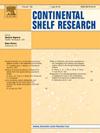Evaluating the hydrodynamic and transport responses to storm surge barriers in a partially mixed Estuary: A case study of the Hudson–Raritan estuary
IF 2.2
3区 地球科学
Q2 OCEANOGRAPHY
引用次数: 0
Abstract
Storm surge barriers (SSB), as engineering measures within broader coastal risk mitigation strategies, have been implemented or proposed in estuaries around the world. During non-storm periods, some parts of barriers restrict cross-flow area which alters water exchange and estuarine hydrodynamics. This study investigates the effects of permanent barrier infrastructure on the hydrodynamics of the Hudson-Raritan Estuary (HRE), a partially mixed estuary characterized by a complex geometry that includes bays connected by tidal straits and multiple tidal inlets. Our research employs a three-dimensional hydrodynamic model (EFDC) to focus on five distinct scenarios developed by the United States Army Corps of Engineers (USACE), exploring aspects of these systems that have not been examined previously. The implementation of SSBs leads to increased salinity content, intrusion, and stratification in tributaries and a decrease on the landward side of the barrier, particularly when key pathways for water exchange are obstructed. Depending on the specific configurations of the SSBs, salinity variations in different regions range from an increase of 12 % to a decrease of 10 %. Results indicate a reduction in both semi-diurnal and diurnal tidal signals across the HRE, significantly affecting the energy partitioning. For instance, an SSB at the Lower Bay entrance reduces the semi-diurnal component of the total energy budget from 73 % in the base case to 46 %, while increasing the subtidal component's contribution from 23 % to 50 %. Additionally, SSBs alter the residual currents, induce eddy formations, and amplify currents across both surface and bottom layers. The response of residence times to SSB configurations varies spatially across the domain; on average, residence time in the HRE rises between 13 % and 67 % across the different SSB configuration scenarios compared to the base case, which has a spatially averaged residence time of approximately 15.9 days. The impact of SSBs on estuarine hydrodynamics strongly depends on their specific location and configuration. This study provides a framework for understanding the potential impacts of any proposed surge barrier systems and enhances our comprehension of their ecological and environmental effects.
部分混合河口对风暴潮屏障的水动力和输运响应评价:以哈德逊-拉坦河口为例
风暴潮屏障(SSB)作为更广泛的沿海风险缓解战略中的工程措施,已在世界各地的河口实施或提出。在非风暴期,某些部分的屏障限制了横流区域,从而改变了水交换和河口水动力。本研究探讨了永久性屏障基础设施对哈德逊-拉坦河口(HRE)水动力的影响,这是一个部分混合河口,其特征是由潮汐海峡和多个潮汐入口连接的海湾组成的复杂几何形状。我们的研究采用三维流体动力学模型(EFDC)来关注美国陆军工程兵团(USACE)开发的五个不同场景,探索这些系统以前未被研究过的方面。SSBs的实施导致了支流盐度含量的增加、入侵和分层,以及屏障向陆侧的减少,特别是当水交换的关键通道受阻时。根据SSBs的具体配置,不同区域的盐度变化幅度从增加12%到减少10%不等。结果表明,整个HRE的半日和日潮汐信号都有所减少,显著影响了能量分配。例如,位于下海湾入口的SSB将总能量预算的半日分量从基本情况的73%减少到46%,同时将潮下分量的贡献从23%增加到50%。此外,ssb改变剩余电流,诱导涡流形成,并放大表面和底层的电流。停留时间对SSB结构的响应在不同区域存在空间差异;平均而言,与基本情景相比,不同SSB配置情景在HRE中的停留时间增加了13%至67%,而基本情景的空间平均停留时间约为15.9天。SSBs对河口水动力的影响很大程度上取决于其特定的位置和结构。本研究为理解任何拟议的浪涌屏障系统的潜在影响提供了一个框架,并增强了我们对其生态和环境影响的理解。
本文章由计算机程序翻译,如有差异,请以英文原文为准。
求助全文
约1分钟内获得全文
求助全文
来源期刊

Continental Shelf Research
地学-海洋学
CiteScore
4.30
自引率
4.30%
发文量
136
审稿时长
6.1 months
期刊介绍:
Continental Shelf Research publishes articles dealing with the biological, chemical, geological and physical oceanography of the shallow marine environment, from coastal and estuarine waters out to the shelf break. The continental shelf is a critical environment within the land-ocean continuum, and many processes, functions and problems in the continental shelf are driven by terrestrial inputs transported through the rivers and estuaries to the coastal and continental shelf areas. Manuscripts that deal with these topics must make a clear link to the continental shelf. Examples of research areas include:
Physical sedimentology and geomorphology
Geochemistry of the coastal ocean (inorganic and organic)
Marine environment and anthropogenic effects
Interaction of physical dynamics with natural and manmade shoreline features
Benthic, phytoplankton and zooplankton ecology
Coastal water and sediment quality, and ecosystem health
Benthic-pelagic coupling (physical and biogeochemical)
Interactions between physical dynamics (waves, currents, mixing, etc.) and biogeochemical cycles
Estuarine, coastal and shelf sea modelling and process studies.
 求助内容:
求助内容: 应助结果提醒方式:
应助结果提醒方式:


